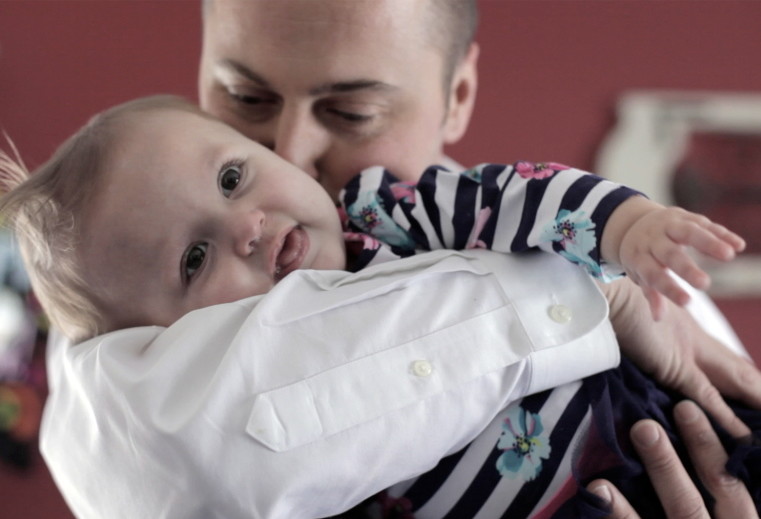Two years ago this month, 8-month-old Erza Bessey died of a disease that his parents had never heard of.
The Besseys, who live in Hallowell, knew early on that something was wrong: Ezra wasn’t using his arms, wasn’t kicking, couldn’t seem to hold his head up. Doctors thought he might have muscular dystrophy.
“So we thought, OK, well, maybe he’ll be in a wheelchair,” says Emily Bessey, 39. “We’ll have to retrofit the house, and we can make this work, and it will be OK.”
But it wasn’t OK.
Ezra had spinal muscular atrophy type 1, a genetic disease in which the muscles throughout the body – including those that control swallowing, walking and breathing – become progressively weak and eventually atrophy. It’s the leading genetic cause of death in infants.
“This disease has often been characterized as the amyotrophic lateral sclerosis or the Lou Gehrig’s disease of babies,” says Dr. Gregory Feero, the associate editor for genomics at the Journal of the American Medical Association. “SMA 1 is a condition that affects something called the lower motor neurons. These are the nerves that come out of the spinal column that serve the muscles and those motor neurons cease to function properly.”
About 1 in 10,000 babies are born with the faulty gene that causes SMA. The life expectancy for most newborns with type 1 – the type that Ezra Bessey had – is less than two years.
“(Ezra) was sitting with us as the doctor is giving us this news, and he’s smiling with these big brown eyes,” Emily Bessey says. “It’s the most heartbreaking thing that you can imagine.”
“We immediately pulled out our phones,” says Ethan Bessey, “and started looking for, number one, what is SMA, and number two, there’s got to be some clinic somewhere. We would fly anywhere, pay anything.”
But there was no lifeline for Ezra. He died Feb. 5, 2013, surrounded by his family.
In Ezra’s memory, the Besseys, along with their pediatrician, started the Hearts for Ezra Foundation.
“That’s one of the things since Ezra’s death that we’ve been trying to work on,” says Emily Bessey, “spreading awareness not only about spinal muscular atrophy, but also about how affordable and available carrier screening is.”
About 1 in every 50 Americans is a carrier of the gene mutation that causes SMA, according to Cure SMA, an Illinois organization devoted to developing a treatment and cure. When both parents are genetic carriers, there’s a 25 percent chance their child will be born with SMA. But carrier screening is not routinely recommended.
“Deciding whether or not to undergo genetic testing is highly personal,” says Megan Lenz, a spokeswoman for Cure SMA. “We strongly recommend discussing it with a physician or genetic counselor. Usually testing is only recommended – and only covered by insurance – for those known to be at risk for genetic diseases.”
Neither Natalia Wylie, 30, nor her husband, Jason, 37, who live in Laconia, New Hampshire, fits that profile. The couple had no family history of genetic disease, and their first child, Samantha, is a healthy 6-year-old. Their second, 10-month old Sofia, was diagnosed with SMA type 1 in July.
“I called my husband right away,” Natalia Wylie says, “and he left work and we spent the day together as a family, kind of crying all day. It was the most painful news I had heard in my entire life.”
But the Wylies decided to set aside their grief and focus instead on the joy that is Sofia – an adorable baby girl with a sweet, sweet smile.
“We couldn’t be unhappy every day. It was going to kill us,” says Natalia. “You’ve got to live day by day and moment to moment.”
Some moments are harder than others. Twice a day – and sometimes every hour when Sofia has a cold – Natalia inserts a catheter in Sofia’s nose and throat to clear secretions that she can’t clear on her own. It’s hard on both of them.
“It’s something I’ll never get used to because it just looks so uncomfortable and painful for her.”
Simple things that most parents take for granted can set off alarm bells for the Wylies.
“I don’t want her to cry. Normally (people) would say, ‘Oh, it’s OK for a baby to cry; it can’t hurt them.’ In her case, it can. The secretions from crying can suffocate her.”
But there are moments to treasure, too. Sofia has learned to high-five with her big sister, and she’s still able to hold her head up for short periods.
The Wylies know the statistics aren’t in their daughter’s favor, but they have a powerful motivator for staying positive: hope. With the cause of the disease now known, Cure SMA’s Lenz says there’s reason to believe the disease is uniquely positioned for research breakthroughs that will lead to a cure.
“It hurts when you find out what the diagnosis is and what the end result usually is,” says Jason Wylie. “But you can’t give up hope.”
Send questions/comments to the editors.





Success. Please wait for the page to reload. If the page does not reload within 5 seconds, please refresh the page.
Enter your email and password to access comments.
Hi, to comment on stories you must . This profile is in addition to your subscription and website login.
Already have a commenting profile? .
Invalid username/password.
Please check your email to confirm and complete your registration.
Only subscribers are eligible to post comments. Please subscribe or login first for digital access. Here’s why.
Use the form below to reset your password. When you've submitted your account email, we will send an email with a reset code.